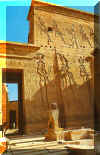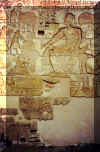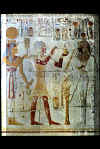Picture Gallery
Other Temples
Click on a picture to enlarge
Isis temple. Built in a lovely location on an island in Aswan, this temple was built to worship the Goddess Isis.
Kom Ombo temple. Beautiful temple overlooking the Nile built for two Gods: Sobek and Haroeris (the Old Horus God)
The Colossi of Memnon in western Thebes, Dynasty XVIII, 1360 B.C. These two sculptures are each carved out of a single block of stone and are about 70 feet high. Each represents King Amenhotep III and are the entrance to his mortuary temple.
The Colossi of Memnon. Notice the small figure of King Amenhotep III's wife on the left statue and that of his mother on the right.
Mortuary complex of King Zoser at Sakkara. Dynasty III, 2780-2680 B.C. This 34 acre mortuary complex contains the king's pyramid (the step pyramid), a small temple, courtyards, a place, shrines, altars, storehouses, and tombs. The complex is surrounded by a perimeter wall and has but one entrance.
Mortuary temple of Ramesses III in Luxor (Dynasty XX, 1175 B.C.). These brilliant pylon reliefs portray Ramesses III on a chariot drawn by horses as he and his archers hunt bulls at the edge of the river. Notice the contrasting scales between the king and his men and the fish carved at the bottom right.
Ramesses III mortuary temple. This is a beautiful carving showing how things hardly change: frustrated by his generals constantly exaggerating the number of enemy soldiers they have killed, he asked for proof. You see the king on the right as first he is shown the hands of the enemy soldiers (top left corner) being counted. Naturally, the generals double-counted by supplying both left and right hands. So below that are only right hands. But the generals again cheated by adding hands of women and children. Next came tongues, with the generals again able to use tongues of women and children. Frustrated, the king asked for the one true count of men that cannot be altered, at the bottom left corner: the enemy soldiers' penises.
Temple of Sety I (Dynasty XIX, 1304-1290 B.C.). This painted tomb relief shows Isis, Sety I as Osiris, and the priest Xun-Mutef.










